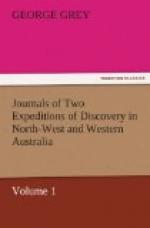INFLUENCE OF MAN ON THEIR HABITS.
A convincing proof of the dread in which man is held by the various kinds of kangaroos is given by their extreme shyness. I never but on two or three occasions got within shot of the larger kangaroos as they were always so wary; and, although I at different times wounded two, I never could succeed in actually capturing either. Now, when the detached party sent forward just before we commenced our return to Hanover Bay crossed a range of mountains on which were neither traces of the natives or their fires, they found the direct reverse of this to be the case, and were all surprised at the tameness of the kangaroos compared with those they had previously seen.
In the same way, when I entered a new district, the birds merely flew up into a lofty tree without attempting to go farther away, and it was not until I had shot for a day or two in the neighbourhood of a place that the birds there became at all wild.
The native dog, doubtless being dependent for subsistence upon the game he can procure, must contribute to thin the numbers of the lesser animals, who also, together perhaps with the rapacious dog himself, frequently fall a prey to the various snakes that inhabit the country; as was evinced in the event narrated on the 16th of March of the destruction, by Mr. Lushington, of the boa with a small kangaroo compressed in its folds.
The manner, too, in which I have seen the rapacious birds of prey soar over plains where the small kangaroos abound, convinces me that they also bear their part in the destruction of this harmless race.
TRACES OF AN ANIMAL WITH A DIVIDED HOOF.
I have already alluded to the paucity of quadrupeds, both in species and in number, but I have still to record the remarkable fact of the existence in these parts of a large quadruped with a divided hoof: this animal I have never seen, but twice came upon its traces. On one occasion I followed its track for above a mile and a half, and at last altogether lost it in rocky ground. The footmarks exceeded in size those of a buffalo, and it was apparently much larger, for, where it had passed through brushwood, shrubs of considerable size in its way had been broken down and, from the openings there left, I could form some comparative estimate of its bulk. These tracks were first seen by a man of the name of Mustard, who had joined me at the Cape, and who had there been on the frontier during the Kaffir war; he told me that he had seen the spoor of a buffalo, imagining that they were here as plentiful as in Africa. I conceived at the time that he had made some mistake, and paid no attention to him until I afterwards twice saw the same traces myself.
BIRDS.
To describe the birds common to these parts requires more time than to detail the names of the few quadrupeds to be found; indeed in no other country that I have yet visited do birds so abound. Even the virgin forests of South America cannot, in my belief, boast of such numerous feathered denizens; yet I cannot, after all, assert that the number of genera and species is at all proportionate to that of individual birds. The contrary is probably the real case.




